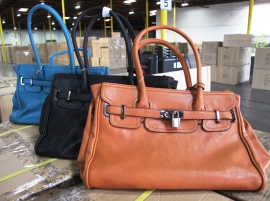The German Federal Agency for Consumer Protection and Food Safety (BVL) published their report on surveillance for the year 2014 on Monday November 23. High hexavalent chromium found in leather products was one of the most often made complaint.
Background:
Chromium (VI) is a known carcinogen and can also cause skin irritation,
corrosion, ulcers, sensitization, and allergic contact dermatitis. It is
hazardous both when inhaled and when a product is in close
contact with the skin. As a potent sensitizer, chromium (VI) can elicit
allergic reactions at very low concentrations in already sensitized
persons. Because of these human health risks, hexavalent chromium is
already restricted in some products such as cement to prevent harm to
workers or electronic equipment to prevent environmental pollution by
waste disposal (see the EVISA Information on Legislation).
Chromium salts are used for leather tanning. Although it is chromium (III) and not chromium (VI) compounds that are
used in the leather tanning process, chromium (VI) can be formed from
chromium (III) via oxidation, a chemical reaction which can be
facilitated by factors like heat, UV radiation, changes in pH,
oxidizing agents and many other factors.
European Legislation:

Leather products suchs as gloves, shoes and
bags must be free of hexavalent chromium
|
Because of the health risks provoked by hexavalent chromium, Cr(VI) should not be present in any leather product with foreseen skin contact such as shoes, gloves etc. Already in 2009, Cr(VI) residues above the detection limit of 3 mg/kg were found in such leather products during a measurement campaign (BÜp) in Germany.
The new report:
The analysis of leather products for hexavalent chromium was repeated in 2014 by evaluating 386 samples. Again hexavalent chromium was found in about 16 % of the samples. Most of the samples questioned were gloves (33 %), bags and backpacks (25%), work clothes (23 %) and shoes (13%). Samples originating from Germany were less often objected (12%) than those from China (33%).
BVL president Dr. Helmut Tschiersky demanded that producers and importers should take care to respect the legal limits.
Source:
Press release of the BVL
 Related EVISA Resources
Related EVISA Resources
 Link Database: Toxicity
of hexavalent chromium (chromate)
Link Database: Toxicity
of hexavalent chromium (chromate)
 Link Database: Industrial Use of chromate
Link Database: Industrial Use of chromate
 Link Database: Chromium in Leather
Link Database: Chromium in Leather
 Link Database: Legislation related to chromium
Link Database: Legislation related to chromium
 Materials Database: Certified reference materials for Cr(VI)
Materials Database: Certified reference materials for Cr(VI)
 Link Database: Methods for chromium speciation analysis
Link Database: Methods for chromium speciation analysis  Brief summary: The Role of elemental speciation on legislation
Brief summary: The Role of elemental speciation on legislation  Brief summary: REACH: Registration, Evaluation and Authorisation of Chemicals
Brief summary: REACH: Registration, Evaluation and Authorisation of Chemicals
 Brief summary: ICP-MS: A versatile detection system for trace element and speciation analysis
Brief summary: ICP-MS: A versatile detection system for trace element and speciation analysis  Brief summary: LC-ICP-MS - The most often used hyphenated system for speciation analysis
Brief summary: LC-ICP-MS - The most often used hyphenated system for speciation analysis  Journals database: Journals related to leather
Journals database: Journals related to leather
 Related EVISA News
Related EVISA News
 March 12, 2014: EU’s proposal to restrict Cr (VI) in leather in final stages
March 12, 2014: EU’s proposal to restrict Cr (VI) in leather in final stages
 May 4, 2013: Standard methods for chromium speciation analysis
May 4, 2013: Standard methods for chromium speciation analysis
 March 10, 2010: ECHA suggests further chemicals for SVHC list
March 10, 2010: ECHA suggests further chemicals for SVHC list Februray 15, 2010: Chromium speciation in solid matrices
Februray 15, 2010: Chromium speciation in solid matrices June 24, 2004: New method for measuring Cr(VI) in Leather
June 24, 2004: New method for measuring Cr(VI) in Leather last time modified: November 26, 2015